Comparison functions in Excel - How to use comparison functions and examples using comparison functions
With a large amount of data, you want to check for duplicates by checking normally, it is really hard. In this article, I introduce you to the Comparison Functions in Excel, with practical examples to help you easily visualize.
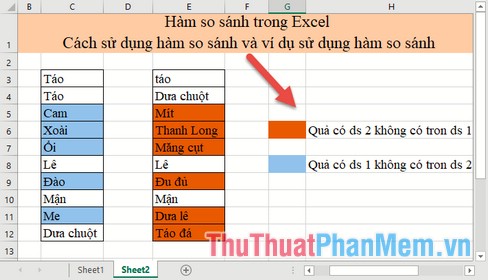
1. Use the Exact function to compare data
Description
The Exact function compares two text strings, returning True if the two strings match, and returning False if the two data strings are different. Note The Exact function is case-sensitive.
Syntax
EXACT (Text1, Text2)
Where: Text1, Text2 are two text strings to be compared, are two required parameters.
Attention
- The Exact function is case sensitive, but it does not distinguish format.
For example
Compare the corresponding data in rows between column 1 and column 2. In the cell to compare enter the formula: EXACT (D4, E4)

Pressing Enter results returns a False value, which means the two values do not match because of the first and lowercase letters:
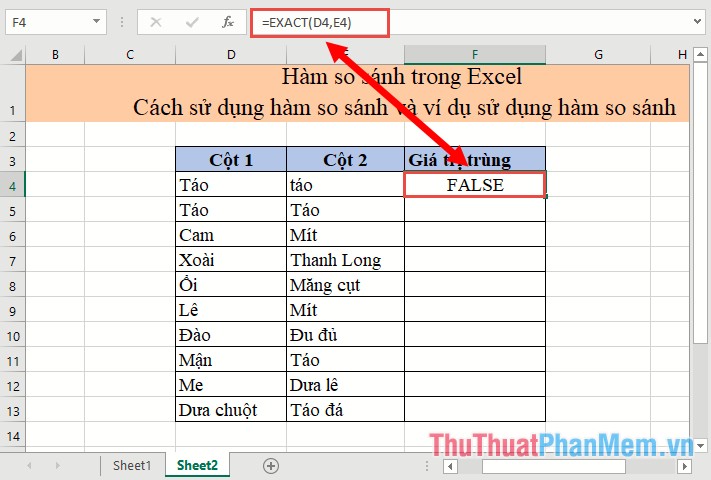
Similarly copying the formula for the remaining values results:

However, with this function, you cannot compare a value in column 1 with all the data in column 2 to find a duplicate. With this function you can only compare rows between themselves.
2. Use the Countif intermediate function to compare data
To overcome the situation in example 1, you can use the Countif function as an intermediary to compare the values in column 1 against the values in column 2.
Description of the Countif function
- Countif function counts the number of cells that meet certain conditions in the selected data range.
Syntax
COUNTIF (Range, Criteria)
Inside:
- Range: The data area containing the data to be counted, is a required parameter.
- Criteria: The condition used to count data, is a required parameter
For example
Compare data between 2 columns, highlight values not in column 1 but in column 2 and vice versa.
Step 1: Name the data columns:
Select the entire column 1 data into the address bar enter listname1 -> press Enter.
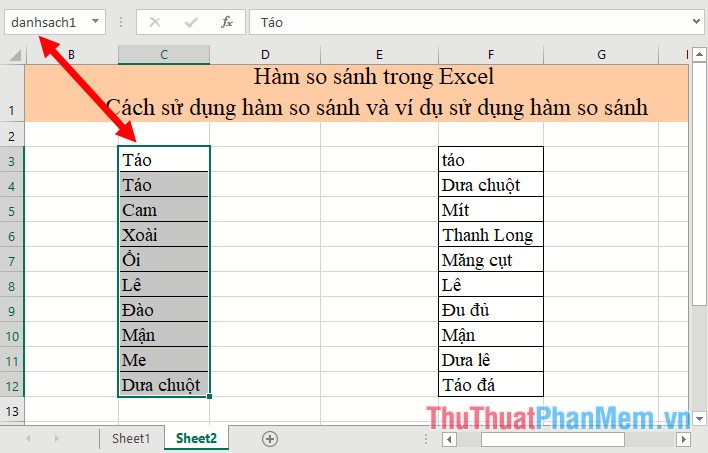
Step 2: Similar to the name of column 2, then the names of 2 data columns are displayed:

Step 3: Select the whole list 1 -> go to Home tab -> Conditional Formatting -> New Rule .

Step 4: A dialog box appears, select Use a formula to determine which cells to format:
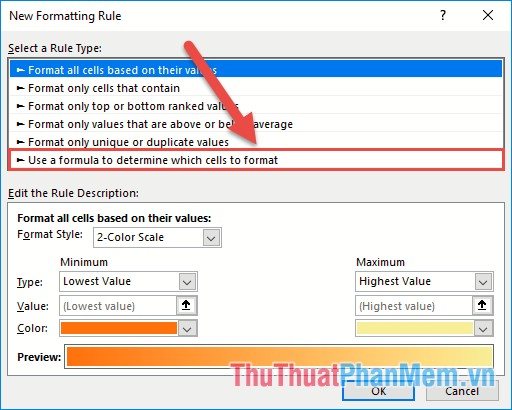
Step 5: Enter the formula = COUNTIF (list2, C3) = 0 then click Format:
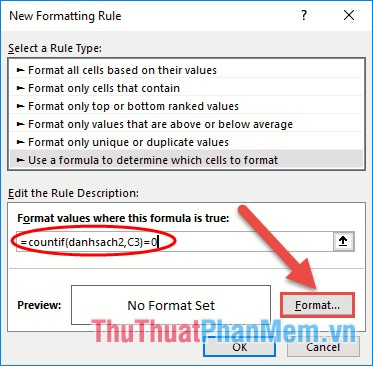
Step 6: The Format Cells dialog box appears, click the Fill tab -> select the color marking the fruit is not in the list 2 -> click OK:
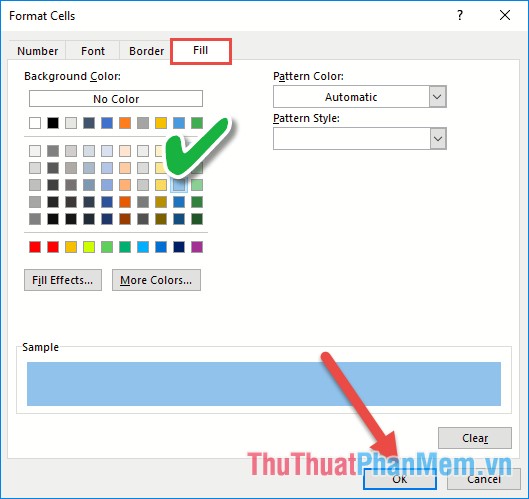
Step 7: Next, click OK to close the resulting fruits dialog box in List 1, which is not in List 2, which is colored to distinguish:
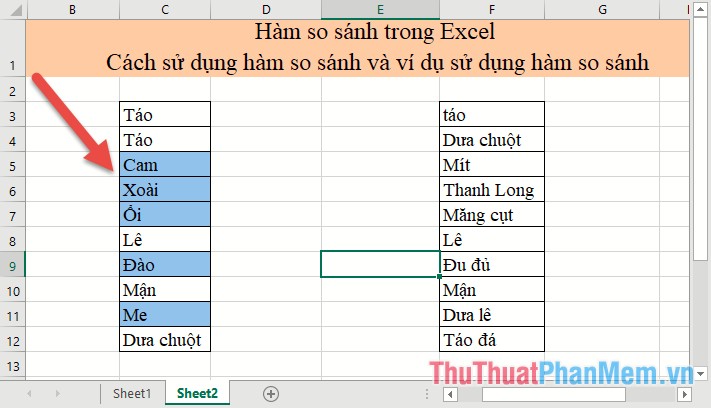
Step 8: Similar to the list 2 you do the same, but only differ from the formula: = COUNTIF (list2, F3) = 0 , it will color the cell with a value of 0 (not the same)
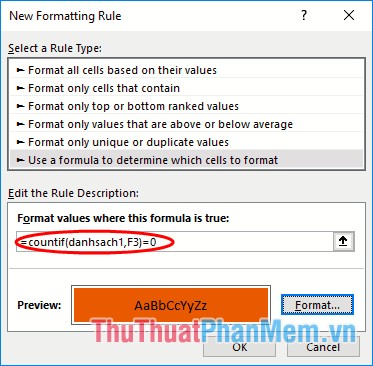
As a result, you have compared 2 columns of data and can add notes for readers to easily visualize:
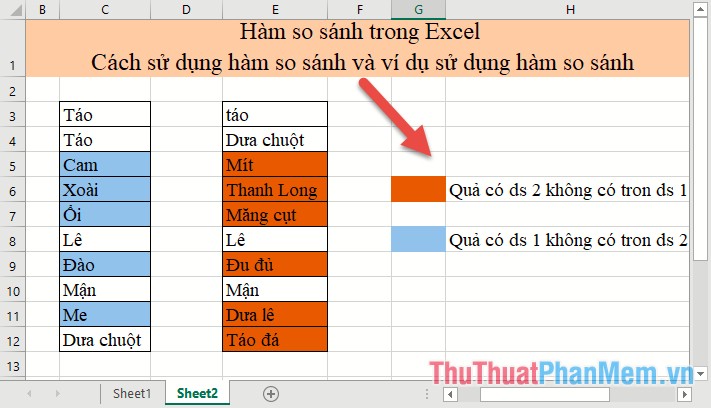
Above is an instruction on how to use EXACT function , application COUNTIF function to compare data in Excel. Good luck!
You should read it
- How to compare texts online
- Complete financial functions in Excel you should know
- 5 websites compare the speed and CPU performance from the most accurate Benchmark point
- Compare performance of iPhone 4S and iPhone 4
- Recursive function in Python
- How to fix the SUM function doesn't add up in Excel
- Matrix functions in Excel
- Exponential functions in Excel - Usage and examples
May be interested
- IRR function in Excel - Usage and examples
 in excel financial functions, users cannot ignore irr - the function that returns the internal rate of return for a series of cash flows. so how does the function structure and usage of the irr function? please read the article below.
in excel financial functions, users cannot ignore irr - the function that returns the internal rate of return for a series of cash flows. so how does the function structure and usage of the irr function? please read the article below. - PMT function in Excel - Usage and examples
 the pmt function is one of the built-in financial functions of the excel software used to calculate the payment for a loan based on regular payments and a constant interest rate. the pmt function is not only useful for businesses, but also very practical for users if you want to calculate a loan.
the pmt function is one of the built-in financial functions of the excel software used to calculate the payment for a loan based on regular payments and a constant interest rate. the pmt function is not only useful for businesses, but also very practical for users if you want to calculate a loan. - Complete financial functions in Excel you should know
 fv, date, time, hour, workday, ... functions are the basic financial functions with the same way of getting color codes in excel. show you how to use these financial functions. click view now!
fv, date, time, hour, workday, ... functions are the basic financial functions with the same way of getting color codes in excel. show you how to use these financial functions. click view now! - VLOOKUP function - Usage and detailed examples
 vlookup is one of the most used excel functions. the following article details how to use and detailed examples when using the vlookup function.
vlookup is one of the most used excel functions. the following article details how to use and detailed examples when using the vlookup function. - DCOUNT function in Excel - Usage and practical examples
 the dcounta function is one of many frequently used math functions in excel. the dcount function helps you count non-blank data cells in list columns or data arrays with defined conditions.
the dcounta function is one of many frequently used math functions in excel. the dcount function helps you count non-blank data cells in list columns or data arrays with defined conditions. - VLOOKUP function to use and specific examples
 vlookup is one of the most useful excel functions but few understand it. in this article, we will help you understand vlookup with practical examples, such as grading students and staff using the vlookup function.
vlookup is one of the most useful excel functions but few understand it. in this article, we will help you understand vlookup with practical examples, such as grading students and staff using the vlookup function. - How to use the IF function in Excel
 the if function in excel helps you easily check conditions and return corresponding results, providing optimal support in calculating and processing data. this is one of the important functions, widely used to automate the comparison and classification of information.
the if function in excel helps you easily check conditions and return corresponding results, providing optimal support in calculating and processing data. this is one of the important functions, widely used to automate the comparison and classification of information. - MS Excel - Lesson 5: Excel formulas and functions
 the formula in excel is a program that performs calculations on data tables. these formulas perform very precise operations such as adding, multiplying, or comparing values in worksheets.
the formula in excel is a program that performs calculations on data tables. these formulas perform very precise operations such as adding, multiplying, or comparing values in worksheets. - MS Excel 2003 - Lesson 5: Excel formulas and functions
 formulas in excel are programs that perform calculations on data tables. these formulas perform very precise calculations such as addition, multiplication, or comparison of values in a worksheet.
formulas in excel are programs that perform calculations on data tables. these formulas perform very precise calculations such as addition, multiplication, or comparison of values in a worksheet. - 8 little-known Excel functions that can save you a lot of work
 even seasoned excel users often find themselves stuck performing tasks manually that could be automated with a few clever functions.
even seasoned excel users often find themselves stuck performing tasks manually that could be automated with a few clever functions.










 How to align in Word - Instructions on how to align in Word 2007, 2010, 2013, 2016
How to align in Word - Instructions on how to align in Word 2007, 2010, 2013, 2016 Delete pages in Word - Instructions on how to delete pages in Word
Delete pages in Word - Instructions on how to delete pages in Word How to make a table of contents in Word 2010
How to make a table of contents in Word 2010 How to create a frame in Word - Instructions on how to create a frame in Word 2007, 2010, 2013, 2016
How to create a frame in Word - Instructions on how to create a frame in Word 2007, 2010, 2013, 2016 How to create tables and tables in Word - Instructions on how to create tables and tables in Word 2007, 2010, 2013, 2016
How to create tables and tables in Word - Instructions on how to create tables and tables in Word 2007, 2010, 2013, 2016 How to split columns in Word - Instructions on dividing columns in Word 2007, 2010, 2013, 2016
How to split columns in Word - Instructions on dividing columns in Word 2007, 2010, 2013, 2016